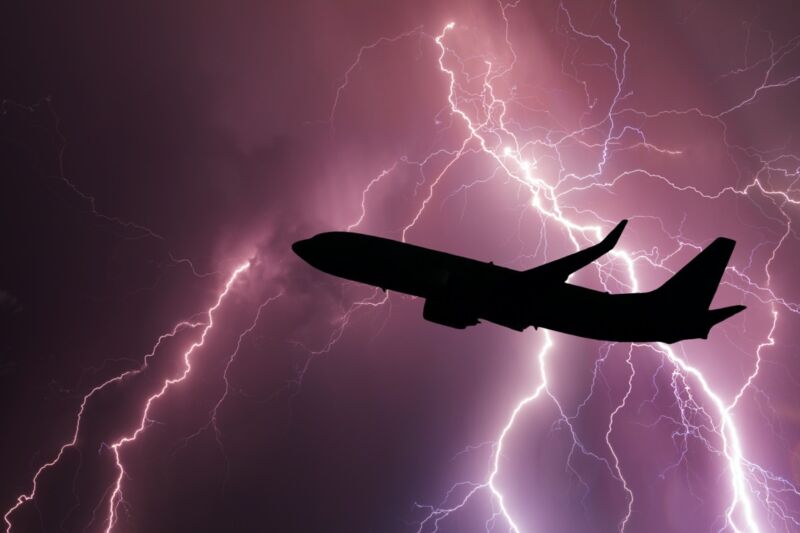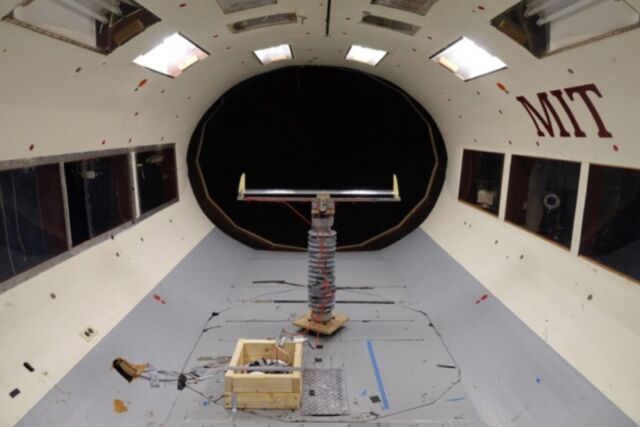
The electrical phenomenon known as St. Elmo's fire manifests during strong thunderstorms as a flash of blue light, usually at the tips of electrically conductive structures like cell phone towers, telephone poles, and ship masts—which is how it got its name, in honor of the patron saint of sailors, St. Erasmus of Formia. On the ground, St. Elmo's fire glows more brightly in windy conditions because the wind helps further electrify the surrounding air.
But MIT scientists have discovered that wind has the opposite effect on ungrounded structures such as airplane wings and turbine blades, according to a recent paper in the Journal of Geophysical Research: Atmospheres. They discovered this while investigating the possibility of using St. Elmo's fire to control the electrical charge of an aircraft, thereby helping protect it from lightning strikes.
St. Elmo's fire is not a form of lightning; it's essentially a continuous electric spark known as a corona discharge, like the glow of a neon sign. The friction that builds up in storm clouds gives rise to an electric field extending to the ground. If it's strong enough, the friction breaks apart surrounding air molecules, ionizing the air to produce a plasma (charged gas). All the excess electrons knock the plasma molecules into an excited state, which then emit photons to produce that telltale glow. The color of the glow depends on the type of gas being ionized. Since Earth's atmosphere is primarily made up of nitrogen and oxygen, the glow takes on a blue or violet hue.
As for why St. Elmo's fire typically forms around sharp, conductive objects, "Air is a good electric insulator. However, if an electric field at the end of a metal rod is strong, air molecules in its vicinity are ionized and charges stream off the end of the rod," electrical engineer William Beaty once explained at Scientific American. "Since an electric field is intensified in regions of high curvature, discharges are intensified at the end of pointed metal rods."

Accounts of the phenomenon date all the way back to ancient Greece. During the Ottoman Empire's 1453 siege of Constantinople, there were reports of St. Elmo's fire shooting out from the top of the Hippodrome, for instance. Ferdinand Magellan's fleet witnessed the phenomenon several times during the expedition's first circumnavigation of the Earth. Charles Darwin wrote about seeing St. Elmo's fire while the HMS Beagle was anchored in the Rio de la Plata: "Even the very masts are pointed with a blue flame." Nikola Tesla created St. Elmo's fire with one of his coils in 1899. And in 2009, there were reports of the phenomenon midflight aboard Air France Flight 447 about 20 minutes before the plane stalled and crashed into the Atlantic Ocean, killing everyone aboard. (St. Elmo's fire was not a factor in the crash, however.)
Carmen Guerra-Garcia of MIT, co-author of this latest paper, studies various aspects of how aircraft interact with lightning. That includes exploring possible practical methods for reducing the risk of lightning strikes. "Developing an alternative approach to the design of lightning-protection measures is particularly important when considering new vehicle configurations (drones, blended-wing bodies), new composite materials, or new concepts like electric aircraft, for which we don't have as much historical information," she told Ars.
About 90 percent of the lightning strikes that hit airplanes are generated by the aircraft itself, because the electrically conductive exterior of the plane serves as a lightning rod. These strikes are not particularly dangerous for the passengers inside the well-insulated cabin, but they can cause damage to the plane, leading to flight delays so additional safety checks can be performed or to a plane being taken out of service entirely. And since newer aircraft incorporate composite materials like carbon fiber, that could increase the risk of lightning-related damage.
In 2018, Guerra-Garcia and several colleagues published a theoretical study exploring how the net electrical charge of an aircraft might have an impact on the probability of the craft itself producing a lightning strike. Their admittedly counterintuitive idea was to develop an onboard system that would electrically charge the aircraft to just the right level, thereby significantly reducing the probability of being struck by lightning.

As a plane flies through a thunderstorm, the exterior can become polarized: one end of the plane is more positively charged and the other end is more negatively charged. When that happens, it can trigger a highly conductive flow of plasma. "You can envision two rapidly propagating ionized channels, one positive and one negative (called leaders), emanating from the aircraft and making the connection to the clouds of ground," said Guerra-Garcia. "We proposed that, by artificially modifying the net charge of the [aircraft], you could decrease the probability of that happening." That's because there is an asymmetry between the two leaders, with the positive leader being favored. "If you charge the [aircraft] to negative values, you make it harder for the positive leader to be initiated," she said.
She and her group tested their hypothesis in a lightning laboratory, with encouraging results. The next step was to determine a means by which one might be able to artificially charge an airplane wing, and the researchers thought they might be able to use St. Elmo's fire. "The corona discharge is the first stage of lightning in general," Guerra-Garcia said. "How corona discharge behaves is important and kind of sets the stage for what could happen next in terms of electrification."
Guerra-Garcia and her team conducted a series of experiments in MIT's Wright Brothers Wind Tunnel (before it was dismantled last year). They built a model of an airplane wing out of wood and wrapped it in foil to make it electrically conductive. They set it on an insulated pedestal so that it was ungrounded. Then they generated a glow corona discharge with a small onboard high-voltage power supply. A metal wire ran parallel to the length of the wing, connecting the high-voltage terminal to the corona-generating electrode and the low-voltage terminal to the airframe. Turning the power on mid-flight produced a glow corona discharge which in turn emitted positive ions.

Next, the researchers subjected the model wing to increasingly strong gusts of wind. They found that the strength of the corona discharge, as well as its brightness, decreased as the wind strengthened—the opposite of what has been observed in grounded objects under windy conditions.
"There is a transient phase during which ions are blown away by the wind, and the airframe charges negatively in response," Guerra-Garcia explained. "We learned several new things about the behavior of a corona discharge in wind when the electrodes are electrically isolated. In addition, we showed that, indeed, you can charge an isolated object, such as an aircraft, using this method—with some limitations, of course."
Granted, there are many variables to consider, such as optimal geometries and wire-wing positions, and once in the air, the only thing you can control is the amplitude of the voyage of the onboard power supply. "For practical purposes, there might be better ways of charging, but this study demonstrates the idea of using charge emission for this purpose," said Guerra-Garcia.
DOI: Journal of Geophysical Research: Atmospheres, 2020. 10.1029/2020JD032908 (About DOIs).
reader comments
59